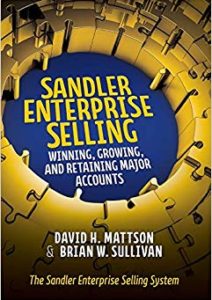I hear the question often. “What is Sandler Enterprise Selling?”. But first, a broader question must be considered. “What is enterprise selling itself?”. Indeed. At Sandler, we believe strongly in pain – the great motivator. “No pain, no sale” is one of our classic quotes. And in selling, while the focus is typically on the prospect’s pain, sales teams feel acute pains as well. So, we define enterprise selling in terms of the unique pains and challenges faced by organizations selling to large enterprise accounts versus small and medium-sized businesses – SMB’s. And while many pains apply, our focus is on those we believe cause the most grief.
First, long sales cycles. With SMB’s, deals can be closed in days, weeks or perhaps a month or two. With enterprise accounts, seasons pass in sales cycles. Often, years go by. And as time passes, doubt, frustration, and risk grow. Effective sales organizations that follow quality processes certainly have an advantage. But the calendar can be harsh.
Next, we focus on business value. With SMB’s, deals are often decided based on price, features or benefits. In enterprise selling, though, it’s all about value – value in the perspective of the account. Selling teams must comprehensively understand their solution, what it will do for the account, how it will deliver benefit and exactly how the benefit will be measured. What it is, what it does, how it benefits and how it’s measured – the customized value proposition. This theme drives your focus throughout the pursuit and well after the business is won.
And then, competition. With SMB’s, no doubt you occasionally knock heads with tough competitors. But with enterprise accounts, sophisticated competitors are everywhere. Competitors you need to account for, understanding their business models, strategies and offerings. But even more, you must understand the value propositions they’ll likely bring to specific deals. That’s right – their what it is, what it does, how it benefits and how it’s measured. In the dark of the night, every cat’s a leopard. It’s your job to turn on the lights.
With smaller accounts, you’re often fortunate to deal directly with the ultimate decision-maker. But in enterprise selling, wide buyer networks assemble individuals bringing different perspectives from Purchasing, Finance, Accounting, Legal and other departments. As if this functional diversity weren’t complex enough, you also need to understand the behavioral profiles of not one individual, but all individuals in the major account network and how they interact.
Then, while cost of sale is important in deals of any size, enterprise pursuits up the ante. The president of a Texas company told me, “When we decide to pursue a deal, it costs us $40,000. Win or lose, $40,000”. A big number, of course, but it represents only the financial costs. What about your people, your most precious resources? When they’re connected to a major pursuit, other activities are delayed or stopped altogether. And if you decide to water down your efforts to pursue deals with less than 100% effort, you’ll face worthy competitors who are all-in, spelling your failure.
With SMB’s, decision structures are usually straightforward. In enterprise accounts, the complications are immense. You must consider issues regarding quotas and set-asides favoring certain competitors. And pivotal factors like ISO 9000, Six Sigma or mandatory certifications complicate pursuits, demanding your best in research, knowledge, and application. Here, what you don’t know will stifle your Go/No-Go decision processes and often lead to losses.
What about team selling? That’s not a challenge, but a powerful enabler that helps you win, right? In a perfect world, perhaps. But try implementing team selling in a large pursuit. Regardless of your organization’s cultural or executive commitment to “Everybody Sells”, the reality is that populating your pursuit team with highly effective colleagues from throughout your organization is easier said than done. Assembling the best resources to develop, propose and present the solution, admirable strategy that it is, can be a huge challenge.
And last, while SMB accounts are generally straightforward, enterprise accounts exhibit vast complexities through their diversification and expansive footprints. You must account for corporate family trees of sister companies, parents, subsidiaries, consortiums, and business partners. And almost always, the accounts are global entities bringing the complications of geography, language, logistics, laws and much more.
In the end, it really is all about pain. If you don’t comprehensively understand and address the accounts’ customized pains in your pursuits, you will almost certainly fail. But success in enterprise selling also demands that you overcome the unique pains that challenge you – the other side of the pain coin. And while It takes teamwork and passionate client focus to win in enterprise selling, you must always remember the sage guidance– “No pain, no sale”. And always look at both sides of the coin.












Comments